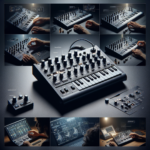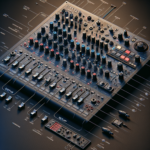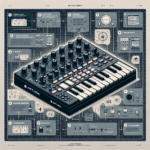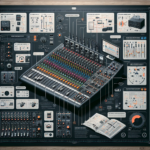PreSonus FaderPort 16: Comprehensive Guide to Features, Setup, and Performance
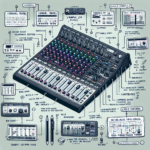
Introduction
The PreSonus FaderPort 16 is a high-end MIDI controller designed to streamline the workflow of music producers, sound engineers, and live performers. This versatile device is aimed at both professionals and serious hobbyists who require precise control over their digital audio workstations (DAWs). With its extensive array of motorized faders, buttons, and knobs, the FaderPort 16 offers a tactile and intuitive interface for managing complex audio projects.
PreSonus is a well-respected brand in the audio industry, known for its innovative and reliable products. The company has built a strong reputation for delivering high-quality audio interfaces, mixers, and controllers that cater to the needs of both amateur and professional musicians.
Key Features Overview:
- 16 motorized faders for precise control
- Comprehensive DAW integration
- High-resolution scribble strips
- Transport controls for easy navigation
- Customizable buttons and functions
- Robust build quality
Design and Build Quality
Physical Design
The PreSonus FaderPort 16 boasts a sleek and professional design. Measuring approximately 18.5 inches in width, 11.5 inches in depth, and 2 inches in height, it is compact enough to fit comfortably on most studio desks. The unit weighs around 10 pounds, making it sturdy yet manageable. The controller is constructed from high-quality materials, including a metal chassis and durable plastic components, ensuring longevity and reliability.
Portability
While the FaderPort 16 is not the most portable controller on the market, its relatively compact size and moderate weight make it feasible to transport for live performances or mobile recording sessions. However, it is best suited for a fixed studio setup where it can remain connected to your DAW and other equipment.
Durability
The build quality of the FaderPort 16 is impressive, with a robust metal chassis that can withstand the rigors of regular use. The motorized faders and buttons are designed to endure extensive operation, providing reliable performance over time. Users can expect this controller to hold up well under both studio and live conditions.
Setup and Configuration
Initial Setup
Setting up the PreSonus FaderPort 16 is straightforward. Follow these steps to get started:
- Unbox the controller and place it on a stable surface.
- Connect the power adapter to the FaderPort 16 and plug it into an electrical outlet.
- Use the provided USB cable to connect the controller to your computer.
- Power on the FaderPort 16 using the switch located on the back of the unit.
Software Installation
To ensure optimal performance, you will need to install the necessary drivers and software:
- Visit the PreSonus website and navigate to the FaderPort 16 product page.
- Download the latest drivers and firmware updates for your operating system.
- Install the drivers by following the on-screen instructions.
- Restart your computer to complete the installation process.
Compatibility
The PreSonus FaderPort 16 is compatible with a wide range of operating systems and DAWs:
- Operating Systems: Windows 10 or later, macOS 10.13 or later
- DAWs: Studio One, Ableton Live, Logic Pro, Pro Tools, Cubase, FL Studio, and more
Features and Functionality
Key Features
The FaderPort 16 is packed with features that enhance its functionality and usability:
- 16 Motorized Faders: These touch-sensitive faders provide precise control over your DAW’s mixer, allowing for smooth and accurate adjustments.
- Scribble Strips: High-resolution displays above each fader show track names and parameter values, making it easy to identify and manage your tracks.
- Transport Controls: Dedicated buttons for play, stop, record, fast forward, and rewind streamline navigation and control.
- Customizable Buttons: Assign functions to various buttons to tailor the controller to your workflow.
Customizability
The FaderPort 16 offers extensive customization options, allowing users to map MIDI functions and assign specific tasks to buttons and faders. This flexibility ensures that the controller can adapt to various workflows and preferences, making it a versatile tool for any studio setup.
Unique Functions
One of the standout features of the FaderPort 16 is its seamless integration with PreSonus Studio One. The controller offers deep integration with this DAW, providing advanced control over various parameters and functions. Additionally, the FaderPort 16 includes a “Session Navigator” section, which allows users to quickly navigate through their projects, adjust zoom levels, and manage markers.
Integration with DAWs
The FaderPort 16 integrates smoothly with popular DAWs, offering dedicated control modes for each. For example:
- Ableton Live: Users can control track volumes, pan, sends, and more with the motorized faders.
- Logic Pro: The controller provides access to mixer functions, transport controls, and plugin parameters.
- FL Studio: Users can manage mixer channels, automation, and transport functions with ease.
Advanced Features
The FaderPort 16 includes several advanced features that enhance its functionality:
- Aftertouch: The touch-sensitive faders respond to pressure, allowing for expressive control over parameters.
- Arpeggiators: While not a traditional feature of the FaderPort 16, users can control arpeggiator settings within their DAW using the controller.
- Chord Modes: Similar to arpeggiators, chord modes can be managed within the DAW using the FaderPort 16’s controls.
Performance
Latency and Responsiveness
The FaderPort 16 excels in terms of latency and responsiveness. The motorized faders react quickly to user input, providing a smooth and accurate control experience. The high-resolution scribble strips update in real-time, ensuring that users have up-to-date information at their fingertips.
Real-World Usage
In practical scenarios, the FaderPort 16 performs admirably. Whether used in a studio setting for mixing and recording or in a live environment for controlling a digital mixer, the controller offers reliable and precise control. Users can expect a seamless experience when integrating the FaderPort 16 into their workflow.
User Experience
Overall, user feedback for the FaderPort 16 is positive. Many users appreciate the tactile feel of the motorized faders and the intuitive layout of the controls. The deep integration with various DAWs is also a highlight, making the controller a valuable addition to any studio setup.
Applications and Use Cases
Beginner vs. Professional Use
The FaderPort 16 is suitable for both beginners and professionals. While its extensive feature set may be overwhelming for newcomers, the intuitive design and comprehensive documentation make it accessible to users of all skill levels. Professionals will appreciate the advanced functionality and seamless DAW integration.
Studio Use
In a studio environment, the FaderPort 16 shines as a powerful tool for music production and recording. Its motorized faders and customizable controls provide precise management of mixer channels, automation, and plugin parameters, enhancing the overall workflow.
Live Performance
The FaderPort 16 is also well-suited for live performances. Its robust build quality and reliable performance make it a dependable choice for controlling digital mixers and managing live sound. The tactile controls allow for quick adjustments, ensuring a smooth and professional performance.
Specific Genres
The FaderPort 16 excels across various genres of music, including EDM, hip-hop, classical, and more. Its versatile feature set and customizable controls make it adaptable to different production styles and workflows.
Pros and Cons
Pros:
- 16 motorized faders for precise control
- Seamless integration with popular DAWs
- High-resolution scribble strips
- Customizable buttons and functions
- Robust build quality
Cons:
- Relatively high price point
- Not the most portable option
- Initial setup may be complex for beginners
Common Issues and Troubleshooting
Known Issues
Some users have reported issues with firmware updates and occasional connectivity problems. These issues are relatively rare and can often be resolved with troubleshooting.
Troubleshooting Tips
- Firmware Updates: Ensure that you are using the latest firmware version. Visit the PreSonus website for updates and follow the installation instructions carefully.
- Connectivity Problems: Check all cable connections and ensure that the controller is properly connected to your computer. Restart your computer and the FaderPort 16 if necessary.
Customer Support
PreSonus offers excellent customer support for the FaderPort 16. Users can access a comprehensive knowledge base, video tutorials, and community forums on the PreSonus website. Additionally, the company provides direct support through email and phone, ensuring that users receive timely assistance with any issues.
Comparisons with Similar Controllers
Competitor Comparison
When compared to similar controllers from other brands, the FaderPort 16 stands out for its extensive feature set and seamless DAW integration. Competitors such as the Behringer X-Touch and the Mackie Control Universal Pro offer similar functionality but may lack the same level of customization and advanced features.
Feature Comparison
The FaderPort 16 excels in areas such as motorized faders, high-resolution scribble strips, and customizable controls. While some competitors may offer additional features such as built-in audio interfaces or more extensive control options, the FaderPort 16’s focus on precision and integration makes it a top choice for many users.
Conclusion
Summary
The PreSonus FaderPort 16 is a powerful and versatile MIDI controller that offers precise control over DAWs and digital mixers. With its 16 motorized faders, high-resolution scribble strips, and customizable controls, it is a valuable tool for both studio and live environments.
Who Should Buy This?
The FaderPort 16 is best suited for music producers, sound engineers, and live performers who require precise and reliable control over their audio projects. Its extensive feature set and seamless DAW integration make it a valuable addition to any professional or serious hobbyist’s setup.
Final Thoughts
Overall, the PreSonus FaderPort 16 is a top-tier MIDI controller that delivers on its promises. Its robust build quality, advanced features, and intuitive design make it a standout choice for anyone looking to enhance their audio production workflow.
FAQ
Is the FaderPort 16 compatible with my DAW?
The FaderPort 16 is compatible with a wide range of DAWs, including Studio One, Ableton Live, Logic Pro, Pro Tools, Cubase, and FL Studio.
Can I use the FaderPort 16 with both Windows and macOS?
Yes, the FaderPort 16 is compatible with both Windows 10 or later and macOS 10.13 or later.
How do I update the firmware on my FaderPort 16?
Visit the PreSonus website to download the latest firmware updates. Follow the on-screen instructions to install the updates on your controller.
What should I do if my FaderPort 16 is not connecting to my computer?
Check all cable connections and ensure that the controller is properly connected to your computer. Restart your computer and the FaderPort 16 if necessary. If the issue persists, contact PreSonus customer support for assistance.
Where to Buy
The PreSonus FaderPort 16 can be purchased from various retailers, including major music equipment stores such as Guitar Center, Sweetwater, and Sam Ash. It is also available through online marketplaces like Amazon and directly from the PreSonus website.

